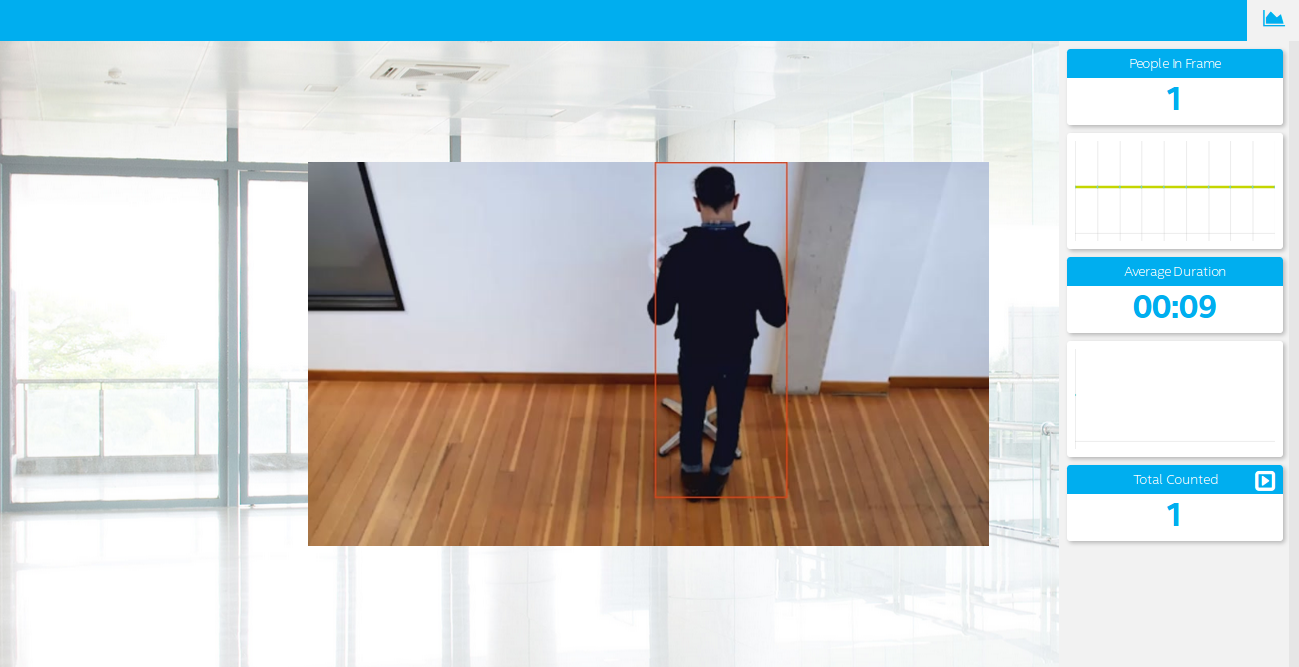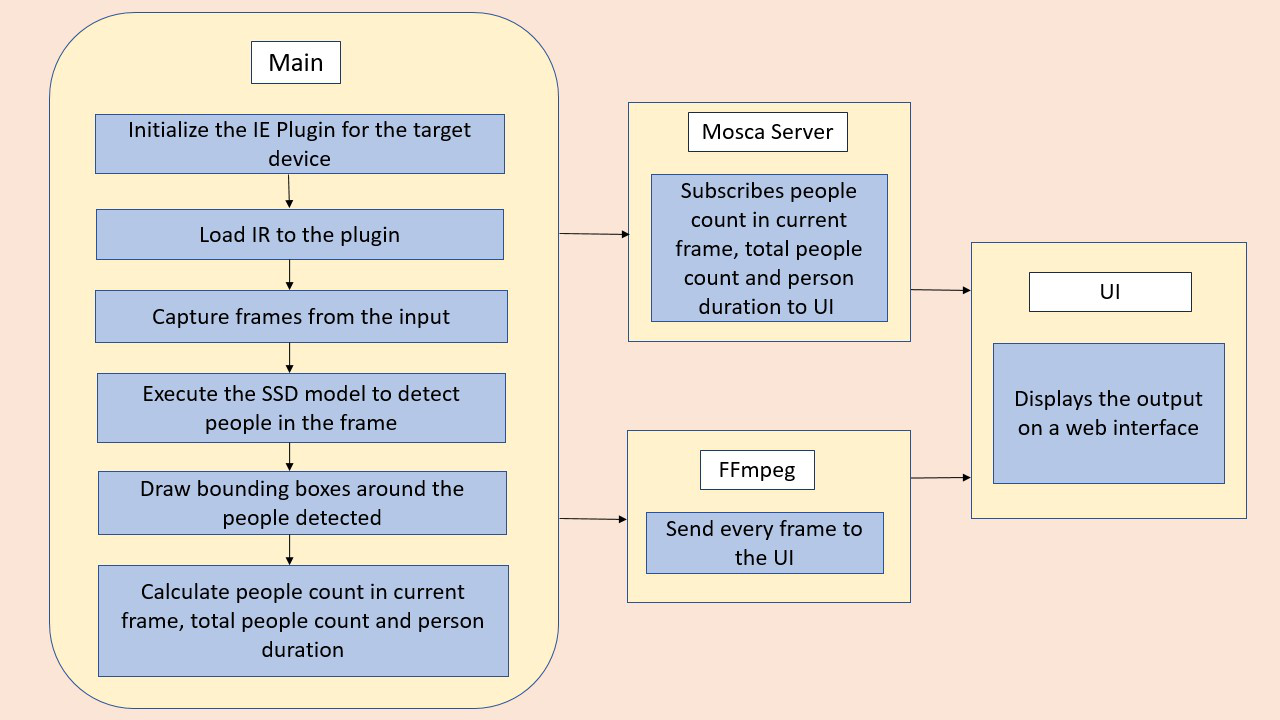| Details | |
|---|---|
| Target OS: | Ubuntu* 16.04 LTS |
| Programming Language: | C++ |
| Time to Complete: | 45 min |
This reference implementation is also available in Python
This people counter application is one of a series of IoT reference implementations illustrating how to develop a working solution for a particular problem. It demonstrates how to create a smart video IoT solution using Intel® hardware and software tools. This people counter solution detects people in a designated area, providing number of people in the frame, their average duration in the frame, and the total count.
The counter uses the Inference Engine included in the Intel® Distribution of OpenVINO™ toolkit. A trained neural network detects people within a designated area by displaying a bounding box over them. It counts the number of people in the current frame, the duration that a person is in the frame (time elapsed between entering and exiting a frame), and the total number of people detected, and then sends the data to a local web server using the Paho* MQTT C client libraries.
- 6th to 8th generation Intel® Core™ processors with Iris® Pro graphics or Intel® HD Graphics.
-
Ubuntu* 16.04 LTS
Note: We recommend using a 4.14+ Linux* kernel with this software. Run the following command to determine your kernel version:uname -a -
OpenCL™ Runtime Package
-
Intel® Distribution of OpenVINO™ toolkit 2019 R1 release
-
Node v6.17.1
-
Npm v3.10.10
-
MQTT Mosca* server
In order to work, the application requires four components running in separate terminals:
- MQTT Mosca server
- Node.js Web server
- FFmpeg server
- Computer vision application (ieservice/bin/intel64/Release/obj_recognition)
Note: Run each in a separate terminal, or using something like tmux.
Before running the MQTT or web server, install the following dependencies:
sudo apt update
sudo apt install libzmq3-dev libkrb5-dev
-
This step is only required if the user previously used Chris Lea's Node.js PPA.
sudo add-apt-repository -y -r ppa:chris-lea/node.js sudo rm -f /etc/apt/sources.list.d/chris-lea-node_js-*.list sudo rm -f /etc/apt/sources.list.d/chris-lea-node_js-*.list.save -
To install Nodejs and Npm, run the below commands:
curl -sSL https://deb.nodesource.com/gpgkey/nodesource.gpg.key | sudo apt-key add - VERSION=node_6.x DISTRO="$(lsb_release -s -c)" echo "deb https://deb.nodesource.com/$VERSION $DISTRO main" | sudo tee /etc/apt/sources.list.d/nodesource.list echo "deb-src https://deb.nodesource.com/$VERSION $DISTRO main" | sudo tee -a /etc/apt/sources.list.d/nodesource.list sudo apt-get update sudo apt-get install nodejs
Refer to Install Intel® Distribution of OpenVINO™ toolkit for Linux* to learn how to set up the toolkit.
Install the OpenCL™ Runtime Package to run inference on the GPU. It is not mandatory for CPU inference.
sudo apt update
sudo apt install libssl-dev
sudo apt-get install doxygen graphviz
cd ~
git clone https://github.com/eclipse/paho.mqtt.c.git
cd paho.mqtt.c
make
make html
sudo make install
sudo ldconfig
This application uses the person-detection-retail-0013 Intel® model, that can be downloaded using the model downloader. The model downloader downloads the .xml and .bin files that will be used by the application.
Steps to download .xml and .bin files:
-
Go to the model_downloader directory using the following command:
cd /opt/intel/openvino/deployment_tools/tools/model_downloader -
Specify which model to download with --name:
sudo ./downloader.py --name person-detection-retail-0013 -
To download the model for FP16, run the following command:
sudo ./downloader.py --name person-detection-retail-0013-fp16
The files will be downloaded inside the /opt/intel/openvino/deployment_tools/tools/model_downloader/Retail/object_detection/pedestrian/rmnet_ssd/0013/dldt directory.
Go to people-counter directory:
cd <path_to_people-counter_directory>
cd webservice/server
npm install
If any configuration errors occur while using npm install, use the commands below:
npm config set registry "http://registry.npmjs.org"
npm install
cd ../ui
npm install
This reference implementation uses ffmpeg to compress and stream video output from cvservice to the webservice clients. FFmpeg is installed separately from the Ubuntu repositories:
sudo apt update
sudo apt install ffmpeg
cd ../server/node-server
node ./server.js
If successful, this message will appear in the terminal:
connected to ./db/data.db
Mosca server started.
Open a new terminal and run the commands below:
cd ../../ui
npm run dev
If successful, this message will appear in the terminal:
webpack: Compiled successfully.
Open a new terminal and run the below commands:
cd ../..
sudo ffserver -f ./ffmpeg/server.conf
Open a new terminal in the current directory and run the below command to set up the environment variables required to run the Intel® Distribution of OpenVINO™ toolkit applications:
source /opt/intel/openvino/bin/setupvars.sh
Note: This command only needs to be executed once in the terminal where the application will be executed. If the terminal is closed, the command needs to be executed again.
This application uses the SSD derived person detection model bundled with the Intel® Distribution of OpenVINO™ toolkit. To do a clean re-build, run the following commands:
cd ieservice
mkdir -p build && cd build
cmake ..
make
The new version of the software will be built as people-counter/ieservice/bin/intel64/Release/obj_recognition. Switch to the directory where the main application was built:
cd ../bin/intel64/Release
Set up the needed MQTT environment variables:
export MQTT_SERVER=localhost:1884
export MQTT_CLIENT_ID=cvservice
./obj_recognition -i Pedestrain_Detect_2_1_1.mp4 -m /opt/intel/openvino/deployment_tools/tools/model_downloader/Retail/object_detection/pedestrian/rmnet_ssd/0013/dldt/person-detection-retail-0013.xml -d CPU -thresh 0.7 | ffmpeg -v warning -f rawvideo -pixel_format bgr24 -video_size 544x320 -i - http://localhost:8090/fac.ffm
To see the output on web based interface, open the link http://localhost:8080 on browser.
-
To use GPU in 16-bit mode, use the following command:
./obj_recognition -i Pedestrain_Detect_2_1_1.mp4 -m /opt/intel/openvino/deployment_tools/tools/model_downloader/Retail/object_detection/pedestrian/rmnet_ssd/0013/dldt/person-detection-retail-0013-fp16.xml -d GPU -thresh 0.7 | ffmpeg -v warning -f rawvideo -pixel_format bgr24 -video_size 544x320 -i - http://localhost:8090/fac.ffmTo see the output on web based interface, open the link http://localhost:8080 on browser.
-
To use GPU in 32-bit mode, use the following command:
./obj_recognition -i Pedestrain_Detect_2_1_1.mp4 -m /opt/intel/openvino/deployment_tools/tools/model_downloader/Retail/object_detection/pedestrian/rmnet_ssd/0013/dldt/person-detection-retail-0013.xml -d GPU -thresh 0.7 | ffmpeg -v warning -f rawvideo -pixel_format bgr24 -video_size 544x320 -i - http://localhost:8090/fac.ffmTo see the output on web based interface, open the link http://localhost:8080 on browser.
./obj_recognition -i Pedestrain_Detect_2_1_1.mp4 -m /opt/intel/openvino/deployment_tools/tools/model_downloader/Retail/object_detection/pedestrian/rmnet_ssd/0013/dldt/person-detection-retail-0013-fp16.xml -d MYRIAD -thresh 0.7 | ffmpeg -v warning -f rawvideo -pixel_format bgr24 -video_size 544x320 -i - http://localhost:8090/fac.ffm
To see the output on web based interface, open the link http://localhost:8080 on browser.
Note: The Intel® Neural Compute Stick can only run FP16 models. The model that is passed to the application, through the -m <path_to_model> command-line argument, must be of data type FP16.
Use the camera ID followed by -i , where the ID is taken from the video device (the number X in /dev/videoX). On Ubuntu, to list all available video devices use the following command:
ls /dev/video*
For example, if the output of the above command is /dev/video0, then camera ID would be: 0
Run the application:
./obj_recognition -i 0 -m /opt/intel/openvino/deployment_tools/tools/model_downloader/Retail/object_detection/pedestrian/rmnet_ssd/0013/dldt/person-detection-retail-0013.xml -d CPU -thresh 0.7 | ffmpeg -v warning -f rawvideo -pixel_format bgr24 -video_size 544x320 -i - http://localhost:8090/fac.ffm
To see the output on web based interface, open the link http://localhost:8080 on browser.

